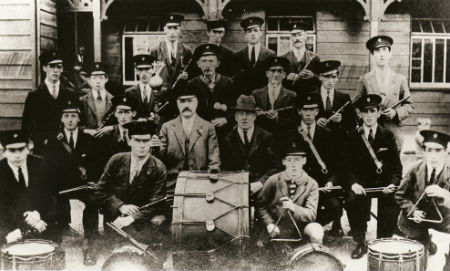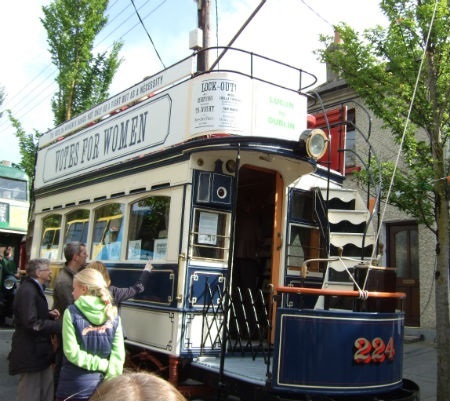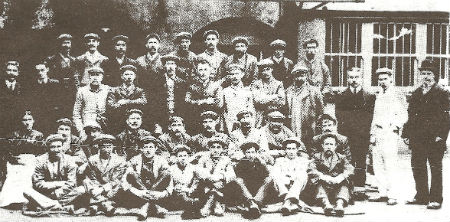|
<< Back to the main Local History page
Activities commemorating the Lockout of 1913 are very much in the news at the moment, and while there is not a lot of documentary evidence on activities in Lucan at the time, a few gems have turned up from various sources.
Firstly, Shackletons Anna Liffey Mills were the first firm to lockout their workers in line with William Murphy's policy. At the time, the mill was run by three brothers – William, George and John Shackleton.
The National Archives contain a small number of documents relating to Shackletons – much of it correspondence to George Shackleton from various people, praising him on his stance at the time. Examples below:
Apparently, Shackletons took on scab labour, and on 27th August, William Martin Murphy wrote to Shackleton:
"I think you will find it necessary to house, and feed, for the present anyhow, the men you get. They are afraid of being molested after they leave their work. We have provided bedding and food for the new men in Independent Office and the Power Station at Ringsend, and we are providing the same at all our Depots for the Drivers and Conductors should any of them be afraid of being assaulted after they leave their work."
In September Domhnall Ua Bhuachalla from Maynooth wrote to Shackletons about the refusal of men to deal with goods from Shackletons:
“I had two yard-men in my employment. They refused to bring your stuff from the station, even after I had tried a little reasonable plain talk with them. I paid them off the same evening, telling them if they considered the maths during the night and thought well of bringing the stuff from the station next morning they might continue in my service. They did not turn in however”.
The National Archives do not have documents from the Shackleton side of things.
A Diary of events at the time was kept by Shackletons, but its location is unknown at the moment.
On August 30, 1913, a news bulletin read:
"It is reported that the Jacobs Biscuit Factory has been closed by its owners. It appears that a number of workers refused to handle a load of flour from Shackleton and Sons of Lucan, which has locked out its Union employees, and as a result the owners have decided to close with immediate effect. This is one of the largest lockouts by an employer in the current round of industrial disruption."
The Lucan Marchers
When John Colgan wrote "Leixlip, Co. Kildare" some years ago, he interviewed Shackleton family members who knew of the diary, and other people who could relate what happened in this area - he wrote as follows:
(at Lucan) "The strikers held a demonstration in which the local band took part. Speeches were made, stones thrown and most of the windows within reach in the mill were shattered.

Lucan Fife and Drum Band
Two nights later, excited by the destruction, Leixlip 'Friends of the Union' marched to Shackletons accompanied by their own towns Fife and Drum Band, gathering reinforcements on their way. Fifty police were on duty in the town and they fell in on the sides of the demonstrators as they marched. When they arrived at the mills much shouting but no further damage was done.
John Shackleton, a courageous man, stood in the doorway with a .45 revolver in his hand and this had a deterring effect. The marchers turned homeward towards the Liffey Bridge at Lucan with the police massed at the back and front of the procession.
Just as they were crossing the bridge the police made a sudden charge from each end. About two dozen men were injured, one seriously, and instruments of the Leixlip Fife and Drum Band were destroyed.
A month later, a big strike rally was held in the Unions retreat Croydon Park, Marino. James O'Neill, of St. Catherines Park, Leixlip, led the Lucan and Leixlip contingents of the recently formed Irish Citizen Army on the march to Dublin.
Another band had been formed and every man was armed with a serviceable stick.
At Lucan the local constabulary joined the marchers. They were heavily built, mainly middle-aged men, who found the journey hot and tiring. The gates of the Union Ground they were refused admission, but the Lucan and Leixlip marchers were provided with rest and refreshments. Later that evening they came out and marched with other units of the Citizen army to the ITGWU premises, Liberty Hall (the old one), in Dublin.
The Lucan police, who had waited outside, fell in with them and again accompanied them. Whey they reached O'Connell Bridge the police sergeant approached O'Neill. "Listen", he said, "you are not going to make your men mach back to Lucan, are you? My men can't stand it. I am willing to pay their train fares home". He did pay and they travelled by tram."

A tram of the day at this year's Lucan Festival
The Coffee House
The Coffee House stood where the entrance to Laraghcon is today – just over the Liffey Bridge. It had been built by Hills and Shackletons in the late 1800s, in the hope that it would serve as an alternative to the pubs of Lucan. It seems not to have worked, but the building became a sort of ‘community centre’ – long before the term was ever invented.
The late Christopher Ledwidge, who was born in Lucan in 1901, referred to it as the ‘Band House’ – where the local Fife and Drum Band had their practices and was often used for dances in his day. He also recalled bread being handed out from here during the great ‘Lockout’ of 1913.
News Report on 2nd December:
"Seventy ITGWU dockers return to work and unload the Antiope, which had been strike-bound for 10 weeks. It contains grain for Shackleton's mill in Lucan, the first company to lock out its workers."
Anna Liffey Mill Workers
Times must have been very worrying for most local employees of Anna Liffey Mills, as many of them and their families were also housed by their employer.
When you think of it, Shackletons owned much property in Lucan including many houses on Main Street and in The Square, as well as a few more on Tinkers Hill and Westmanstown.
This was a battle that the workers could not win, but consequently conditions did improve for workers all over Ireland.

Some Anna Liffey Mill Workers from that era…
Front L-R: R. Behan, B.Rogers, - Maher, J. Howlett, D. Behan, D. Neill, J. Neill, Jim Neill.
2nd Row: Mary Blair, J. Byrne, J. Kilmurray, C. Byrne, R. Kane, G. Howlett, P. Connolly, L. Kelly, W. Brady.
3rd Row: M. Whelan, J. Byrne, J. O'Hara, M. Buggle, J. Kellaghan, P. Buggle, P. Morris, P. Cullen, J. Cullen, F. Webb, W. Freeman, W. Handy.
Back Row: - Baggot, J. Kelly, H. Byrne, J. Fitzpatrick, - Baggot, P. Daly, W. Connolly, T. Beck, T. Daly.
Mary Mulhall
|

